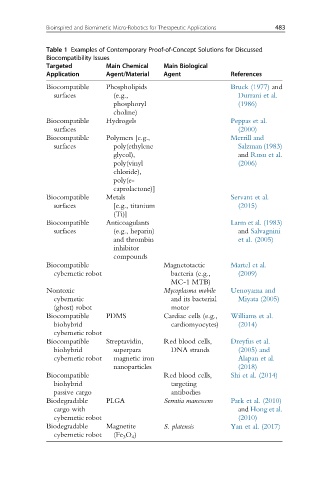Page 489 - Handbook of Biomechatronics
P. 489
Bioinspired and Biomimetic Micro-Robotics for Therapeutic Applications 483
Table 1 Examples of Contemporary Proof-of-Concept Solutions for Discussed
Biocompatibility Issues
Targeted Main Chemical Main Biological
Application Agent/Material Agent References
Biocompatible Phospholipids Bruck (1977) and
surfaces (e.g., Durrani et al.
phosphoryl (1986)
choline)
Biocompatible Hydrogels Peppas et al.
surfaces (2000)
Biocompatible Polymers [e.g., Merrill and
surfaces poly(ethylene Salzman (1983)
glycol), and Rusu et al.
poly(vinyl (2006)
chloride),
poly(e-
caprolactone)]
Biocompatible Metals Servant et al.
surfaces [e.g., titanium (2015)
(Ti)]
Biocompatible Anticoagulants Larm et al. (1983)
surfaces (e.g., heparin) and Salvagnini
and thrombin et al. (2005)
inhibitor
compounds
Biocompatible Magnetotactic Martel et al.
cybernetic robot bacteria (e.g., (2009)
MC-1 MTB)
Nontoxic Mycoplasma mobile Uenoyama and
cybernetic and its bacterial Miyata (2005)
(ghost) robot motor
Biocompatible PDMS Cardiac cells (e.g., Williams et al.
biohybrid cardiomyocytes) (2014)
cybernetic robot
Biocompatible Streptavidin, Red blood cells, Dreyfus et al.
biohybrid superpara DNA strands (2005) and
cybernetic robot magnetic iron Alapan et al.
nanoparticles (2018)
Biocompatible Red blood cells, Shi et al. (2014)
biohybrid targeting
passive cargo antibodies
Biodegradable PLGA Serratia marcescens Park et al. (2010)
cargo with and Hong et al.
cybernetic robot (2010)
Biodegradable Magnetite S. platensis Yan et al. (2017)
cybernetic robot (Fe 3 O 4 )

